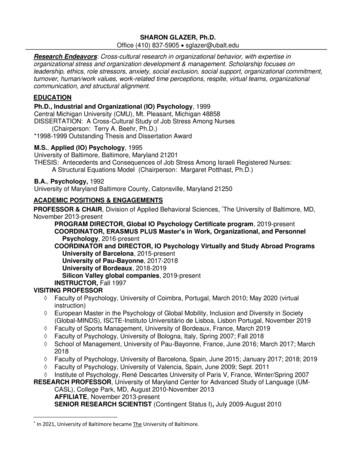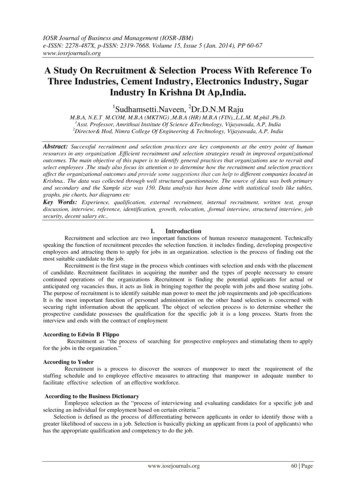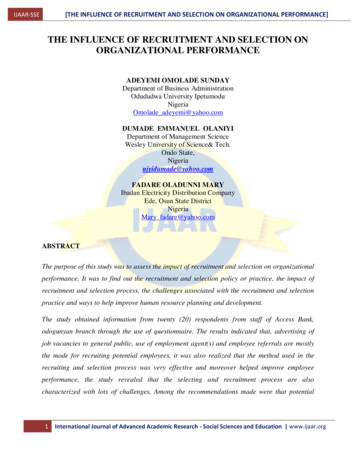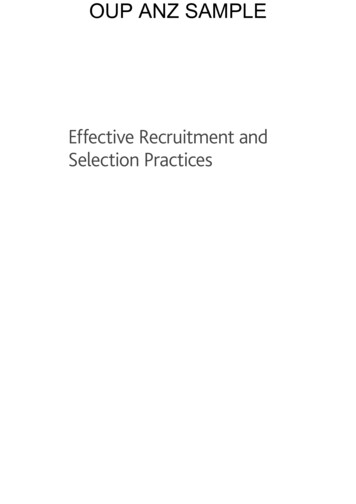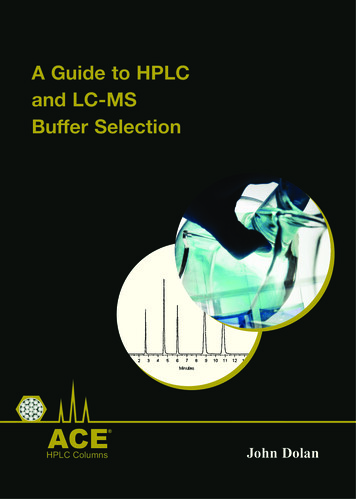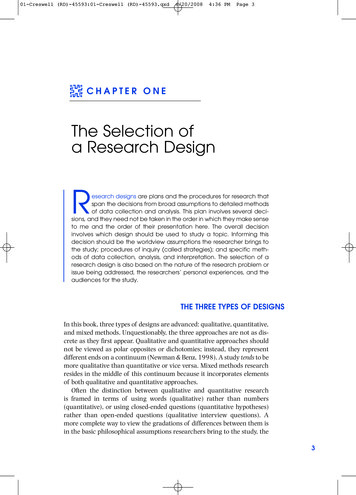
Transcription
01-Creswell (RD)-45593:01-Creswell (RD)-45593.qxd6/20/20084:36 PMPage 3CHAPTER ONEThe Selection ofa Research DesignResearch designs are plans and the procedures for research thatspan the decisions from broad assumptions to detailed methodsof data collection and analysis. This plan involves several decisions, and they need not be taken in the order in which they make senseto me and the order of their presentation here. The overall decisioninvolves which design should be used to study a topic. Informing thisdecision should be the worldview assumptions the researcher brings tothe study; procedures of inquiry (called strategies); and specific methods of data collection, analysis, and interpretation. The selection of aresearch design is also based on the nature of the research problem orissue being addressed, the researchers’ personal experiences, and theaudiences for the study.THE THREE TYPES OF DESIGNSIn this book, three types of designs are advanced: qualitative, quantitative,and mixed methods. Unquestionably, the three approaches are not as discrete as they first appear. Qualitative and quantitative approaches shouldnot be viewed as polar opposites or dichotomies; instead, they representdifferent ends on a continuum (Newman & Benz, 1998). A study tends to bemore qualitative than quantitative or vice versa. Mixed methods researchresides in the middle of this continuum because it incorporates elementsof both qualitative and quantitative approaches.Often the distinction between qualitative and quantitative researchis framed in terms of using words (qualitative) rather than numbers(quantitative), or using closed-ended questions (quantitative hypotheses)rather than open-ended questions (qualitative interview questions). Amore complete way to view the gradations of differences between them isin the basic philosophical assumptions researchers bring to the study, the3
01-Creswell (RD)-45593:01-Creswell (RD)-45593.qxd46/20/20084:36 PMPage 4Preliminary Considerationstypes of research strategies used overall in the research (e.g., quantitativeexperiments or qualitative case studies), and the specific methodsemployed in conducting these strategies (e.g., collecting data quantitatively on instruments versus collecting qualitative data through observinga setting). Moreover, there is a historical evolution to both approaches,with the quantitative approaches dominating the forms of research in thesocial sciences from the late 19th century up until the mid-20th century.During the latter half of the 20th century, interest in qualitative researchincreased and along with it, the development of mixed methods research(see Creswell, 2008, for more of this history). With this background, itshould prove helpful to view definitions of these three key terms as used inthis book: Qualitative research is a means for exploring and understandingthe meaning individuals or groups ascribe to a social or human problem.The process of research involves emerging questions and procedures, datatypically collected in the participant’s setting, data analysis inductivelybuilding from particulars to general themes, and the researcher makinginterpretations of the meaning of the data. The final written report has aflexible structure. Those who engage in this form of inquiry support a wayof looking at research that honors an inductive style, a focus on individualmeaning, and the importance of rendering the complexity of a situation(adapted from Creswell, 2007). Quantitative research is a means for testing objective theories byexamining the relationship among variables. These variables, in turn, canbe measured, typically on instruments, so that numbered data can be analyzed using statistical procedures. The final written report has a set structure consisting of introduction, literature and theory, methods, results,and discussion (Creswell, 2008). Like qualitative researchers, those whoengage in this form of inquiry have assumptions about testing theoriesdeductively, building in protections against bias, controlling for alternativeexplanations, and being able to generalize and replicate the findings. Mixed methods research is an approach to inquiry that combinesor associates both qualitative and quantitative forms. It involves philosophical assumptions, the use of qualitative and quantitative approaches,and the mixing of both approaches in a study. Thus, it is more than simply collecting and analyzing both kinds of data; it also involves the use ofboth approaches in tandem so that the overall strength of a study isgreater than either qualitative or quantitative research (Creswell & PlanoClark, 2007).These definitions have considerable information in each one of them.Throughout this book, I discuss the parts of the definitions so that theirmeanings become clear to you.
01-Creswell (RD)-45593:01-Creswell (RD)-45593.qxd6/20/20084:36 PMPage 5The Selection of a Research DesignTHREE COMPONENTS INVOLVED IN A DESIGNTwo important components in each definition are that the approach toresearch involves philosophical assumptions as well as distinct methodsor procedures. Research design, which I refer to as the plan or proposalto conduct research, involves the intersection of philosophy, strategies ofinquiry, and specific methods. A framework that I use to explain the interaction of these three components is seen in Figure 1.1. To reiterate, inplanning a study, researchers need to think through the philosophicalworldview assumptions that they bring to the study, the strategy of inquirythat is related to this worldview, and the specific methods or procedures ofresearch that translate the approach into practice.Philosophical WorldviewsAlthough philosophical ideas remain largely hidden in research (Slife &Williams, 1995), they still influence the practice of research and need tobe identified. I suggest that individuals preparing a research proposal or planmake explicit the larger philosophical ideas they espouse. This informationwill help explain why they chose qualitative, quantitative, or mixed methodsSelected Strategiesof InquiryPhilosophicalWorldviewsPostpositiveSocial tive strategies(e.g., ethnography)Quantitative strategies(e.g., experiments)Mixed methods startegies(e.g., sequential)Research DesignsQualitativeQuantitativeMixed methodsResearch MethodsQuestionsData collectionData analysisInterpretationWrite-upValidationFigure 1.1A Framework for Design—The Interconnection of Worldviews, Strategiesof Inquiry, and Research Methods5
01-Creswell (RD)-45593:01-Creswell (RD)-45593.qxd66/20/20084:36 PMPage 6Preliminary Considerationsapproaches for their research. In writing about worldviews, a proposalmight include a section that addresses the following: The philosophical worldview proposed in the study A definition of basic considerations of that worldview How the worldview shaped their approach to researchI have chosen to use the term worldview as meaning “a basic set ofbeliefs that guide action” (Guba, 1990, p. 17). Others have called themparadigms (Lincoln & Guba, 2000; Mertens, 1998); epistemologies and ontologies (Crotty, 1998), or broadly conceived research methodologies (Neuman,2000). I see worldviews as a general orientation about the world and thenature of research that a researcher holds. These worldviews are shaped bythe discipline area of the student, the beliefs of advisers and faculty in a student’s area, and past research experiences. The types of beliefs held by individual researchers will often lead to embracing a qualitative, quantitative,or mixed methods approach in their research. Four different worldviews arediscussed: postpositivism, constructivism, advocacy/participatory, and pragmatism. The major elements of each position are presented in Table 1.1.The Postpositivist WorldviewThe postpositivist assumptions have represented the traditional form ofresearch, and these assumptions hold true more for quantitative researchthan qualitative research. This worldview is sometimes called the scientificmethod or doing science research. It is also called positivist/postpositivistresearch, empirical science, and postpostivism. This last term is called postpositivism because it represents the thinking after positivism, challengingTable 1.1Four WorldviewsPostpositivismConstructivism Determination Reductionism Empirical observationand measurement Theory verification Advocacy/ParticipatoryPragmatism PoliticalEmpowerment ndingMultiple participant meaningsSocial and historical constructionTheory generationConsequences of actionsProblem-centeredPluralisticReal-world practice oriented
01-Creswell (RD)-45593:01-Creswell (RD)-45593.qxd6/20/20084:36 PMPage 7The Selection of a Research Designthe traditional notion of the absolute truth of knowledge (Phillips &Burbules, 2000) and recognizing that we cannot be “positive” about ourclaims of knowledge when studying the behavior and actions of humans.The postpositivist tradition comes from 19th-century writers, such asComte, Mill, Durkheim, Newton, and Locke (Smith, 1983), and it has beenmost recently articulated by writers such as Phillips and Burbules (2000).Postpositivists hold a deterministic philosophy in which causes probably determine effects or outcomes. Thus, the problems studied by postpositivists reflect the need to identify and assess the causes that influenceoutcomes, such as found in experiments. It is also reductionistic in that theintent is to reduce the ideas into a small, discrete set of ideas to test, suchas the variables that comprise hypotheses and research questions. Theknowledge that develops through a postpositivist lens is based on carefulobservation and measurement of the objective reality that exists “outthere” in the world. Thus, developing numeric measures of observationsand studying the behavior of individuals becomes paramount for a postpositivist. Finally, there are laws or theories that govern the world, andthese need to be tested or verified and refined so that we can understandthe world. Thus, in the scientific method, the accepted approach toresearch by postpostivists, an individual begins with a theory, collects datathat either supports or refutes the theory, and then makes necessary revisions before additional tests are made.In reading Phillips and Burbules (2000), you can gain a sense of the keyassumptions of this position, such as,1. Knowledge is conjectural (and antifoundational)—absolute truthcan never be found. Thus, evidence established in research is always imperfect and fallible. It is for this reason that researchers state that they do notprove a hypothesis; instead, they indicate a failure to reject the hypothesis.2. Research is the process of making claims and then refining or abandoning some of them for other claims more strongly warranted. Mostquantitative research, for example, starts with the test of a theory.3. Data, evidence, and rational considerations shape knowledge. In practice, the researcher collects information on instruments based on measurescompleted by the participants or by observations recorded by the researcher.4. Research seeks to develop relevant, true statements, ones that canserve to explain the situation of concern or that describe the causal relationships of interest. In quantitative studies, researchers advance the relationship among variables and pose this in terms of questions or hypotheses.5. Being objective is an essential aspect of competent inquiry;researchers must examine methods and conclusions for bias. For example,standard of validity and reliability are important in quantitative research.7
01-Creswell (RD)-45593:01-Creswell (RD)-45593.qxd86/20/20084:36 PMPage 8Preliminary ConsiderationsThe Social Constructivist WorldviewOthers hold a different worldview. Social constructivism (often combinedwith interpretivism; see Mertens, 1998) is such a perspective, and it istypically seen as an approach to qualitative research. The ideas came fromMannheim and from works such as Berger and Luekmann’s (1967) The SocialConstruction of Reality and Lincoln and Guba’s (1985) Naturalistic Inquiry.More recent writers who have summarized this position are Lincoln and Guba(2000), Schwandt (2007), Neuman (2000), and Crotty (1998), among others. Social constructivists hold assumptions that individuals seek understanding of the world in which they live and work. Individuals developsubjective meanings of their experiences—meanings directed toward certainobjects or things. These meanings are varied and multiple, leading theresearcher to look for the complexity of views rather than narrowing meanings into a few categories or ideas. The goal of the research is to rely as muchas possible on the participants’ views of the situation being studied. The questions become broad and general so that the participants can constructthe meaning of a situation, typically forged in discussions or interactions withother persons. The more open-ended the questioning, the better, as theresearcher listens carefully to what people say or do in their life settings. Oftenthese subjective meanings are negotiated socially and historically. They arenot simply imprinted on individuals but are formed through interaction withothers (hence social constructivism) and through historical and culturalnorms that operate in individuals’ lives. Thus, constructivist researchers oftenaddress the processes of interaction among individuals. They also focus on thespecific contexts in which people live and work, in order to understand thehistorical and cultural settings of the participants. Researchers recognize thattheir own backgrounds shape their interpretation, and they position themselves in the research to acknowledge how their interpretation flows fromtheir personal, cultural, and historical experiences. The researcher’s intent isto make sense of (or interpret) the meanings others have about the w
standing of the world in which they live and work. Individuals develop subjective meanings of their experiences—meanings directed toward certain objects or things. These meanings are varied and multiple, leading the researcher to look for the complexity of views rather than narrowing mean-ings into a few categories or ideas. The goal of the research is to rely as much as possible on the .


